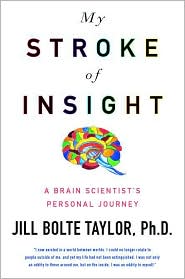|
My Stroke of Insight: A Brain Scientist's Personal Journey by Jill Bolte Taylor Published by Viking Penguin 177 pages, 2008
|
A Bolte From the Blue Reviewed by Mary Ward Menke
Imagine being a 37-year-old woman, an accomplished professional, well-respected among your peers. You’re healthy, your future is bright, and then suddenly, your whole world collapses. The very thing you’ve devoted your life to studying -- the brain -- has betrayed you. A blood vessel has burst inside your head and you’ve suffered a massive stroke. That’s what happened to Dr. Jill Bolte Taylor, a neuroanatomist -- brain scientist -- on the morning of December 10, 1996. In My Stroke of Insight, Taylor describes the event and her subsequent lengthy recovery from a clinical and very personal point of view. Like many non-brain scientists, about the only thing I know about the brain is the difference between left- and right-brain function -- the left being the part of the brain associated with logic, and the right being associated with creativity; the left controlling the right side of the body and vice-versa. So while I was fascinated with Taylor’s description of what she observed as the stroke was progressing, I found it difficult to wrap my head around (pun intended). If the stroke occurred in the left side of her brain, the language center, how was she able to comprehend and commit to memory -- in words -- what was happening?
Her struggle to get help on that morning is exhausting and painful to read; one can only imagine what it must have been like living it. She writes about waiting for intermittent waves of clarity “that would permit my mind to connect two thoughts and give me a chance at forming an idea, a chance to execute a plan.” She was unable to rationalize calling 9-1-1, but somehow remembered her mother’s telephone number and understood that her mother lived thousands of miles away, so it wouldn’t do much good to call her. In another moment of clarity, she remembered she worked at the Harvard Brain Tissue Resource Center, but trying to remember the phone number there was a major challenge:
It took 45 minutes before Taylor was finally able to make the call. However, when she finally got through to her coworker, she was unable to form words or sentences and could only make unintelligible noises. Fortunately her colleague recognized her voice, understood the seriousness of the situation and hurried to her apartment. In the meantime, she spent another 35 minutes searching for her doctor’s business card and dialing her number. Although by now Taylor was in even worse shape, the receptionist astutely transferred the call to Taylor’s doctor, who slowly and deliberately repeated the information advising Taylor to go to the hospital. (Wouldn’t it have made more sense for the doctor to have sent an ambulance?) By the time Taylor arrived at the hospital, she was curled up in a fetal position and existing largely in the right hemisphere of her brain -- which she refers to as “la-la land,” a state of euphoria from which she had little desire to escape. Here, all were one. There were no boundaries, no shapes; rather than seeing a complete form, she saw pixels. Her thought processes were characterized by a non-verbal, intuitive method of information-processing. In the five days she was hospitalized, she observed the rest of the world as it went on around her, acutely aware of the feelings attached to her caregivers. Some were attentive and obviously caring individuals; others never made eye contact and raised their voices when they spoke to her, not realizing she could hear quite well, but was merely unable to understand or respond. Her mother, G.G. (a nickname stemming from her maiden name, Gladys Gillman) soon arrived to care for Taylor and had to convince her daughter to let the doctors operate to remove the golf-ball-sized clot on her brain. Taylor gives her mother most of the credit for her complete recovery, which took eight years, noting that stroke recovery can take much longer than we used to think was the case.
For stroke victims and their families, friends and caregivers, the Appendices titled “Recommendations for Recovery” contain valuable information such as “Ten Assessment Questions” and “Forty Things I Needed the Most.” Today, Taylor says that the stroke is the best thing that ever happened to her. She learned the value of the right-hemisphere function in providing feelings of peace and well-being and that we can side-step negative left-brain emotions such as anger and jealousy by viewing them as the transient emotions they are and choosing not to dwell on them.
At fewer than 200 pages, the book is easily read in a day or two. However, it could have been condensed even more. The two chapters devoted to an explanation of the brain sound too much like a high school science textbook and detract from the otherwise slice-of-life storytelling style, although the “Warning Signs of Stroke” is a valuable addition. And the last few chapters dwell in the “la-la-land” of New Age theories like Feng Shui and energy dynamics, a little of which goes a long way, especially for those readers whose consciousness hasn’t been raised quite that far. Still, for those who have been impacted by stroke as well as those who are simply interested in the mechanics of the human mind, My Stroke of Insight is an important and highly-recommended book. | September 2008
Mary Ward Menke is a contributing editor to January Magazine and the owner of WordAbilities, LLC, providing writing and editing services to businesses and individuals. Her work has been published in The Toastmaster, Dog Fancy and Science of Mind magazines, in the Suburban Journals (a weekly St. Louis community newspaper) and on STLtoday.com. |

